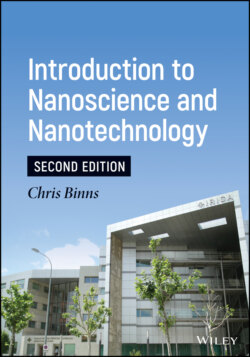Читать книгу Introduction to Nanoscience and Nanotechnology - Chris Binns - Страница 12
I.1 Incremental Nanotechnology
ОглавлениеAll substances, even solid chunks of metal, have a grain structure and controlling this grain structure allows one to produce higher performance materials. This could mean stronger metals, magnetic films with a very high magnetization, suspensions of nanoparticles with tailored properties, etc. There are aspects of incremental nanotechnology that date back to the ancients, for example, the invention of Indian ink, probably in China around 2700 BCE, which arose from the production of carbon nanoparticles in water. Also, medieval potters in Europe knew how to produce a luster on pots by coating them with copper and silver nanoparticles [3], a process that can be traced back to ninth century AD Mesopotamia. Figure I.2 shows an electron microscope image of the glaze of a sixteenth century Italian pot, whose luster derives from the coating by 10 nm diameter copper particles.
Most modern nanotechnologists would be proud of the size control of the particles in this picture. Whereas these days a process that involved nanoparticles such as this would be proudly claimed to be nanotechnology, and thus, open the door to research funding, spin‐off companies, etc. The ancients were developing processes that did something invisible to the materials, but nevertheless allowed them to achieve visible changes. In this sense, a lot of incremental nanotechnology can sometimes be considered to be a re‐branding of other more traditional lines of research such as materials science. The nanotechnology title is still useful, however, since nanotechnology is, by its nature, multi‐disciplinary and it encourages cross‐disciplinary communication between researchers.
The aspect of incremental nanotechnology that has really changed in the modern world is the development of instruments (see Chapter 5) that can probe at the nanoscale and image the particles within materials or devices. Researchers can actually observe what is happening to the particles or grains in response to changes in processing. This not only makes development of new processes more efficient, but also leads to the discovery of completely new structures that were not known to exist and hence new applications. Nature is full of surprises when one studies sufficiently, small pieces of matter, as will be come clear throughout this book.
Figure I.2 Ancient incremental nanotechnology. Copper nanocrystals of about 10 nm in diameter on a tenth century pot, which produce a surface luster. The inset shows an increased magnification image of a single 7 nm diameter particle with atomic planes visible revealing its crystallinity.
Source: Reproduced with permission from [3].
